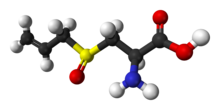Alliin
[3] The first reported synthesis, by Stoll and Seebeck in 1951,[4] begins the alkylation of L-cysteine with allyl bromide to form deoxyalliin.Oxidation of this sulfide with hydrogen peroxide gives both diastereomers of L-alliin, differing in the orientation of the oxygen atom on the sulfur stereocenter.A newer route, reported by Koch and Keusgen in 1998,[5] allows stereospecific oxidation using conditions similar to the Sharpless asymmetric epoxidation.Garlic has been used since antiquity for conditions now associated with oxidative stress (production and accumulation of reactive oxygen species (ROS)).[6] Alliin has also been found to affect immune responses in blood cells in vitro.



CAS NumberChEMBLChemSpiderECHA InfoCardEC NumberPubChemCompTox DashboardSMILESChemical formulaMolar massMelting pointSolubility in waterGHS labellingPictogramsHazard statementsPrecautionary statementsNFPA 704Safety data sheetstandard statesulfoxidegarlicamino acidcysteinealliinaseallicindiallyl disulfidediallyl trisulfideajoenestereochemistryallyl bromidehydrogen peroxidediastereomerssulfurstereocenterSharpless asymmetric epoxidationdiethyl tartratetitanium isopropoxidereactive oxygen speciesin vitroantioxidanthydroxylradicalRoyal Society of Chemistry